Lukla airport
In the distance, we spot a flicker of a plane, the loud hum of its engines purring as it approaches. It rises up through the Khumbu Valley and lines up for the painted guidelines on the runway, then descends sharply and a loud roar emerges as it touches down neatly and powers up the hill perfectly in line with the guidelines. It turns the corner and approaches the terminal. Pretty impressive considering this is supposed to be the most dangerous airport in the world.
The most dangerous airport in the world?
The runway is just 1,729 feet compared to a typical 10,000 feet. Its 12% gradient is to help slow landing planes and prevent a crash into the sheer wall at the top of the runway. At the bottom end of the runway, there is a sheer drop of 2,000 ft to the valley floor. Poor visibility can make it difficult to see the landing strip and weather conditions change fast in the Himalayas.
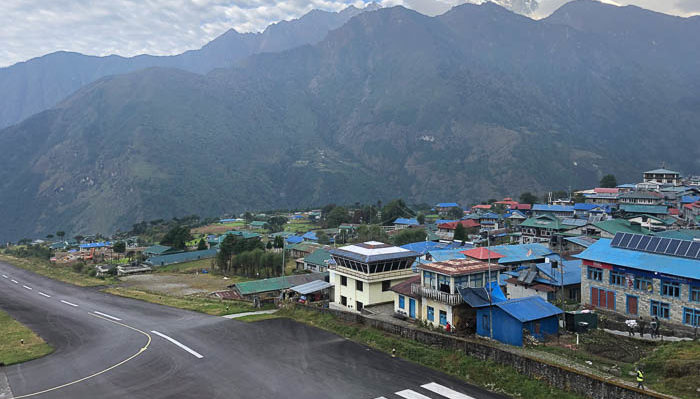
Accidents have happened and there is no second chance. Due to the mountainous terrain it is not possible to go around if the landing looks compromised!! (Source: Forbes) Pilots need to be confident and experienced!! So it is unsurprising that it has a reputation for being the ‘most dangerous airport in the world.‘
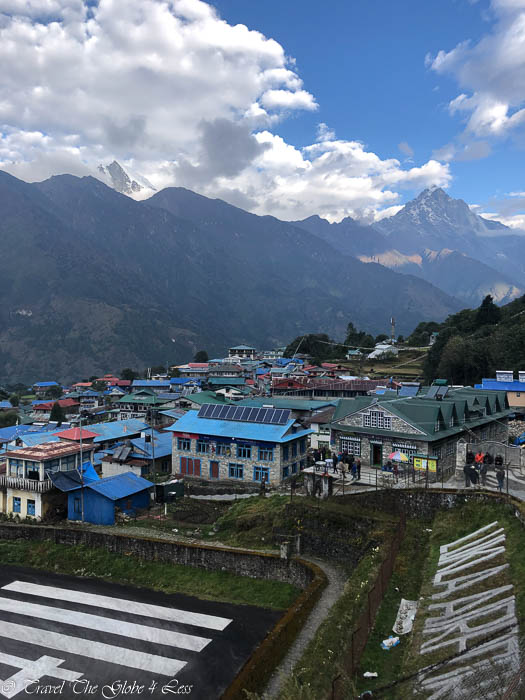
Lukla airport turnarounds
It is not all bad, however. Lukla airport has to have the quickest turnaround known the man. Passengers are already lined up by the gate as planes pull up to within a touching distance of the building. Within minutes they board the plane and it’s off. It’s fascinating to watch! We only hope we will have more luck today with flights than we did on our arrival day.
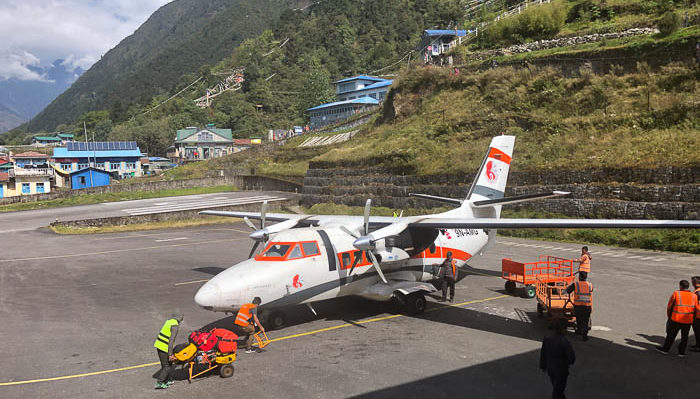
Our departure
We start our wait at a nearby hotel. Our guide, John, has advised us that ‘someone will come‘ when it is our turn. We settle in to play games of cards and chat about the events of our trek. A call goes up, we excitedly collect our things and head up the path for the short walk to the Tenzing-Hillary airport.
Thank god we have local representation in the form of one of our sherpas, Ming. The airport is chaotic and we have no idea what is happening as we arrive at the terminal. Mini Ming (Ming’s son who is really called Dor Je) collects our passports as we look on nervously. After a long wait, Kamal (another of our wonderful Sherpas) emerges from the airline office with a pile of passports and boarding passes and heads to the check-in desks. There they throw all the bags of our group onto a huge weighing scale. It’s nowhere near as stressful on the return leg as we have given away so much stuff that our weight is comfortably below the allowance.
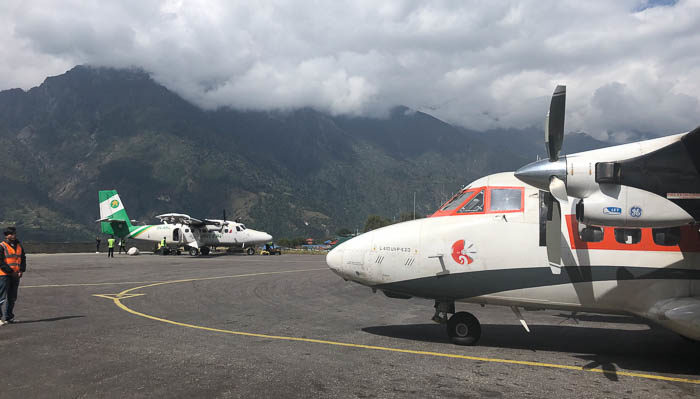
Next they weight the main luggage collectively. Bags must then pass ‘baggage inspection’ which is a cursory glance at our bags and the strangest question. ‘Have you got rocks in your bag?’ Good lord it was hard enough getting our weight under 10kg without rocks!! It seems it is a valid question however, as a few in our group have indeed picked up mementoes from Everest Base Camp. You know who you are!!
Once checked, the bags are shoved into a big slide which leads to the tarmac ready to load onto the plane.
Security at Lukla airport
We pass to security which is another cursory glance at some of the liquids, and another random question ‘have you got trekking poles in there?!’ I’m through security and hopeful for our flight ahead.
I have to chuckle as I spot Dor Je hovering by the security to pick up confiscated items. He seems very happy with his stash of deoderants and other toiletries and I suspect he has done this before.
Our flight to Manthali
Before long, it is time to board and we give our Sherpas final hugs and fist pumps. I feel tears welling in my eyes and try to surreptiously wipe them away (although this group are probably used to seeing me cry by now!!). We clamber onboard excitedly, strap ourselves in and listen to the shortest hostess briefing ever.
Then with a little bounce, the plane hurtles down the runway and we cheer as it lifts up into the valley to make the short plane ride back to Manthali.
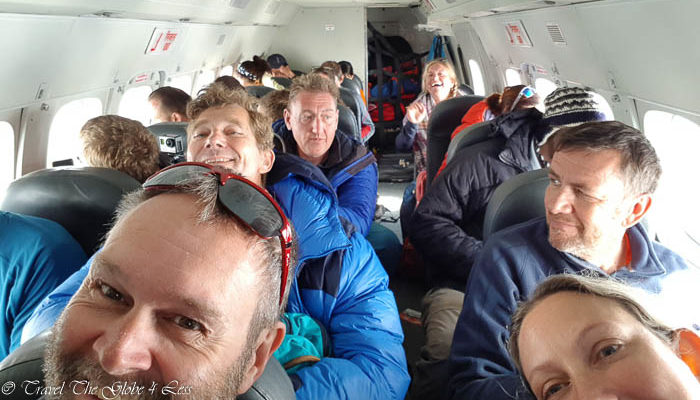
In just 25 minutes we land on the tarmac, a world away from our mountains and at least 5 degrees warmer. We collect our bags and settle in for the long drive back to Kathmandu.
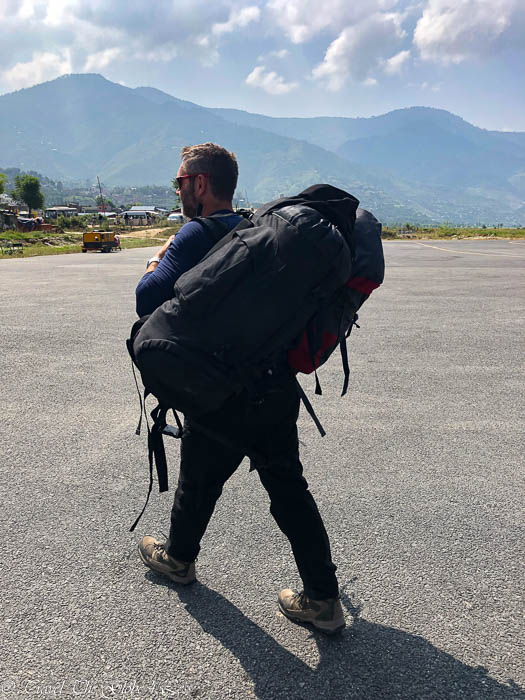
Read more:
This post is the last of twelve dedicated to our daily exploits on our Everest Base Camp trek. You can read all the others here.
Everest Base Camp trek – day one, day two, day three, day four, day five, day six, day seven, day eight, day nine, day ten, and day eleven.
The posts aim to give you insight into what an Everest Base Camp trek is really like, warts and all. However, be under no illusions. Whilst the trek is difficult at times, especially if you get altitude sickness or become ill, it is undoubtedly the best thing I have ever done.
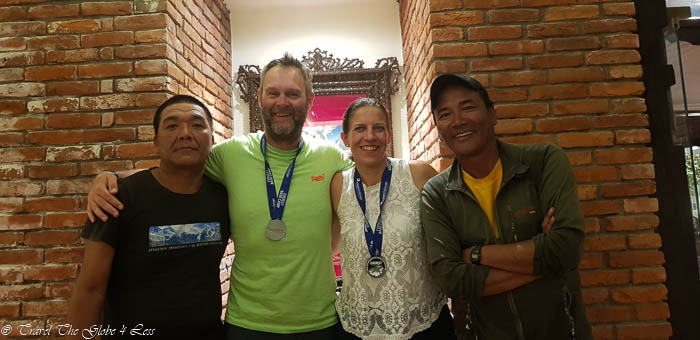
Our Everest Base Camp trek
Why Everest Base camp?
We trekked to EBC to help raise funds for Bluebell Wood Children’s Hospice, and if you would like to donate, please visit our justgiving page.
 From Miles to Smiles Stylish travel for professionals seeking luxury at affordable prices
From Miles to Smiles Stylish travel for professionals seeking luxury at affordable prices
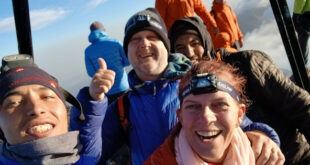
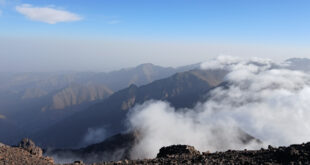
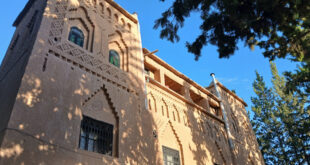
Amazing Blog that Very Informative!!
Great posts. Thanks! (Fascinating to contrast your experiences with ours in 1978 on the same route.) 100% agree with your summation “Whilst the trek is difficult at times, especially if you get altitude sickness or become ill, it is undoubtedly the best thing I have ever done.”
Wow you went in 1978. That must have been massively different. I’m guessing it was much less commercial but perhaps less facilities? I’d love to hear more about that experience
Yes, totally different. Runway was grass. Few buildings. One airline, Royal Nepal Airlines, owned by the king I think, flying Twin Otters from Kathmandu only on the clearest of clear days (flights cancelled 3 days prior to us but we got lucky). I remember seeing size C and D batteries warming on window sills in the sun as there was no electricity and very few windows. We all crowded around the airplane to retrieve our bags after landing with lots of locals looking on hoping we would hire them as porters. The 3 of us had pre-arranged through Sherpa Co-op for 2 young men (may 14 yrs old) and an older woman (probably in her 40’s), Pasang, Pasang, and Dedee. Along the route and in Namche, a few hotels and teahouses which were primarily 2 story affairs, with the restaurant on ground floor and a few rooms upstairs. Trekkers were small in number so many of us got to know one another along the way as we were all on the same acclimatization schedule. Some good links in Wikipedia under Tenzing–Hillary Airport.
That sounds amazing. Some people have asked me if they think too many people are there now as it looks busy in some of the photos on the various blogs I did. I wouldn’t agree with that as 1,000 trekkers a week across 70 miles of terrain is not really congested however I can imagine it was very different when you were there. We did however keep bumping into the same groups so I know exactly what you mean. Furthermore, I bumped into someone I knew at BC so after that we continually were bumping into one another, even back in Kathmandu!